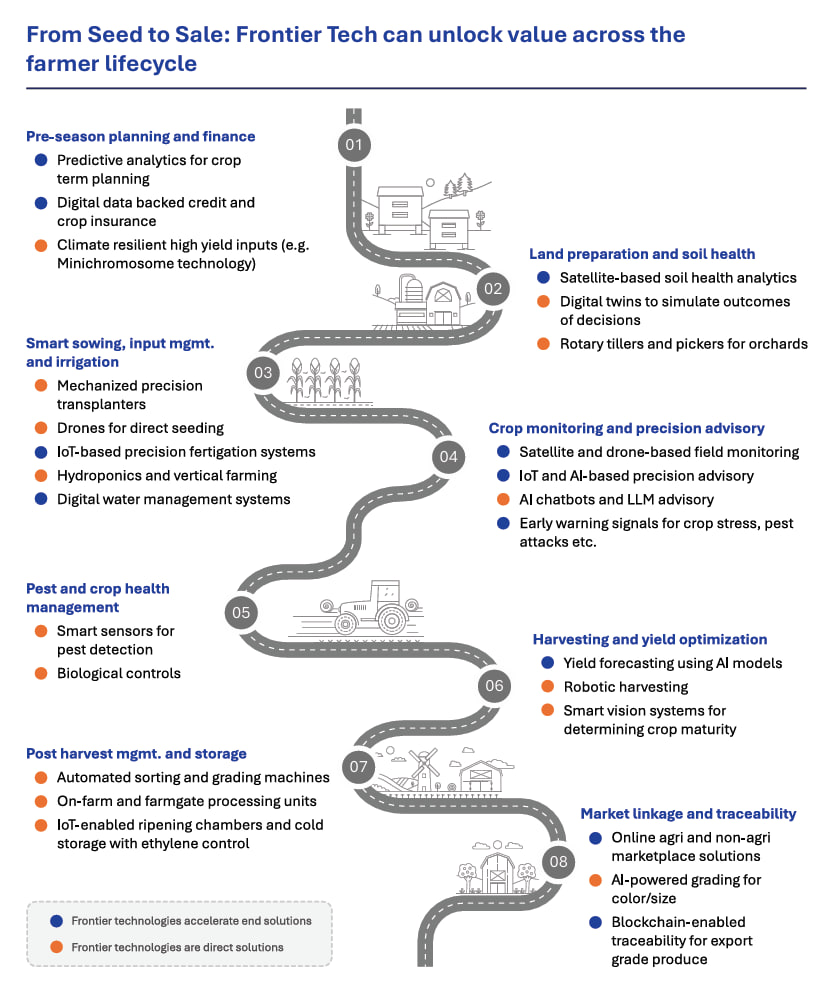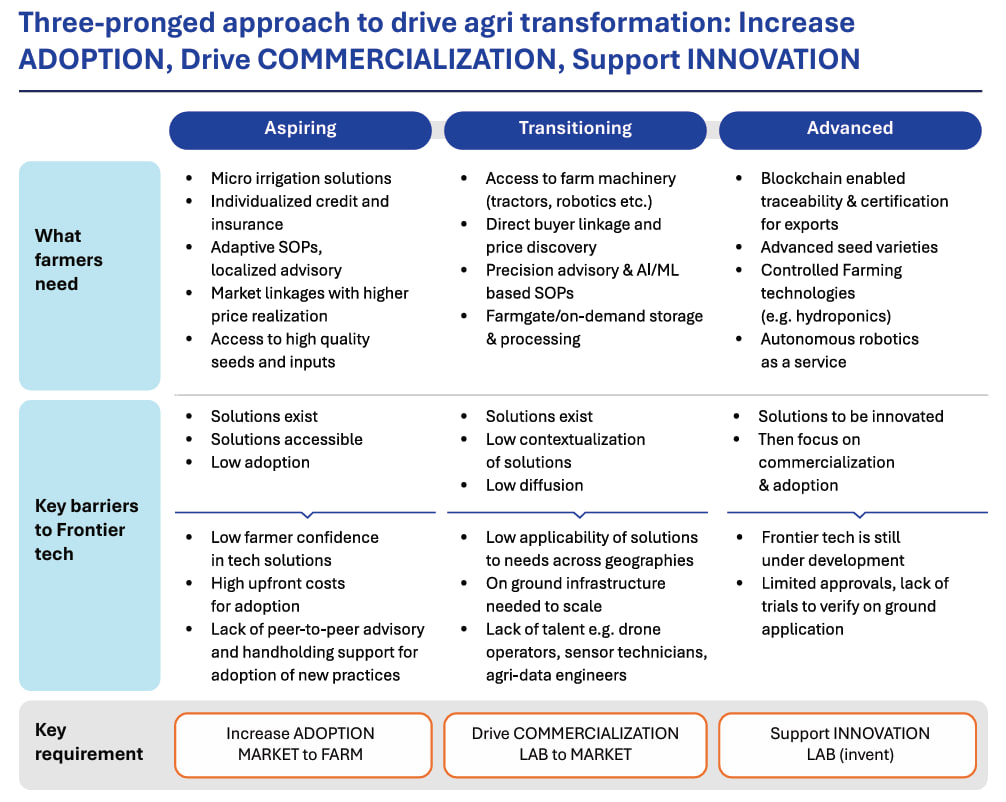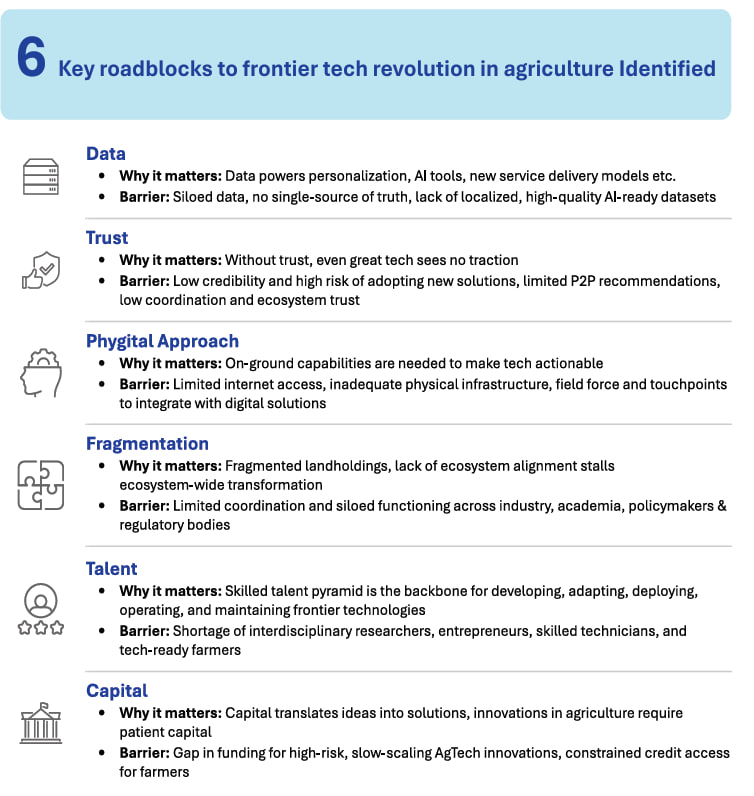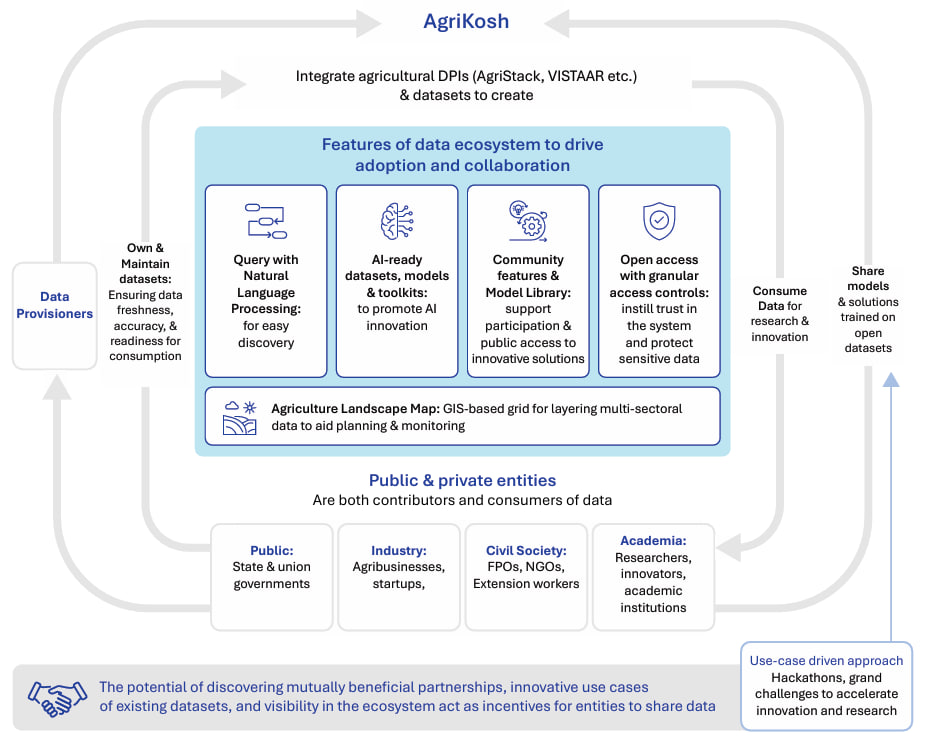



Copyright infringement not intended
Picture Courtesy: PIB
Indian agriculture, employing 45.8% of the workforce and producing 1 billion tonnes annually, struggles with fragmented land, low mechanization, post-harvest losses, and climate vulnerability.
NITI Aayog's "Reimagining Agriculture" roadmaps plans to integrate advanced tech by 2047, creating a sustainable, inclusive, and tech-powered agricultural sector, aligning with the "Viksit Bharat" vision.
NITI Aayog proposes an "Intelligent Agricultural Revolution," using AI and data to shift farming from input-based to intelligence-driven, boosting productivity, sustainability, and farmer income.
The roadmap proposes a "Digital Agriculture Mission 2.0," anchored on three pillars:
 To ensure equitable transformation, the report categorizes farmers into three types: "Aspiring" (70-80%), "Transitioning" (15-20%), and "Advanced" (1-2%), suggesting customized strategies for each group.
To ensure equitable transformation, the report categorizes farmers into three types: "Aspiring" (70-80%), "Transitioning" (15-20%), and "Advanced" (1-2%), suggesting customized strategies for each group.

 Key Technologies Driving the Transformation
Key Technologies Driving the TransformationArtificial Intelligence (AI) and Machine Learning (ML)
Facilitate real-time, precision-based advisories for weather, pest control, and yield forecasting. For example, a pilot project in Telangana showed AI adoption leading to a 21% increase in yield and a 9% reduction in input costs.
Internet of Things (IoT)
IoT sensors continuously monitor soil, water, and climate parameters, enabling precise irrigation, fertilization, and pest management, optimizing resource use and reducing environmental impact.
Drones
Drones provide efficient crop monitoring, early disease detection, and precision spraying of fertilizers and pesticides, preventing crop loss and minimizing chemical use.
Blockchain and Data Sovereignty
Blockchain ensures transparent farm-to-fork traceability, guarantees fair pricing, and safeguards farmer data ownership within digital value chains.
Jivabhumi Agri Tech Private Limited, an Indian startup, uses Blockchain, Cloud, and Mobility to digitize agriculture for a safer, transparent, and traceable food supply chain, implementing solutions in Karnataka and Jharkhand.
Biotechnology and Genetic Engineering
Frontier gene-editing tools like CRISPR and biofortification enhance crop tolerance to drought, heat, and pests while improving nutritional value, crucial for climate resilience.
Geographical Information Systems (GIS)
GIS technology is vital for targeted nutrient management through soil fertility maps and real-time decision support. It is also used by the Digital Agriculture Mission for farm monitoring and precision farming.
Small and Fragmented Landholdings
Around 86% of farmers are smallholders, owning less than 1 hectare of land on average, making advanced farm mechanization and digital oversight economically unviable and difficult to implement.
 Digital Divide and Low Digital Literacy
Digital Divide and Low Digital Literacy
Only 25% of farmers are comfortable using digital tools like smartphones and the internet. A 2022 World Bank survey reported that merely 23.4% of adult rural Indians possess basic digital literacy.
The lack of digital fluency limits farmers' ability to access and leverage new technologies effectively.
Lack of Robust Infrastructure
Inconsistent internet connectivity and power supply issues in rural areas hinder the adoption of digital tools. Less than 50% of rural areas in India have reliable internet connectivity.
The disparity in tele-density, with rural tele-density at 58.8% as of October 2025, compared to urban tele-density at 133.72%, presents a major challenge. (Source: PIB)
High Initial Cost and Limited Access to Credit
New agri-tech is unaffordable for small farmers, and limited funding for agri-tech businesses stifles innovation.
The average operational holding size of 1.08 hectares makes investment in pricey sensors or drones challenging. (Source: PIB)
Data Inconsistency and Trust Deficit
Data is often misaligned across various systems, leading to inconsistencies; smallholders exhibit low trust in technology, partly due to a lack of awareness and knowledge.
Inadequate Extension Services and Skill Gaps
Current extension services struggle to effectively share knowledge about new technologies.
There is a shortage of AI-agriculture expertise and only 7% of rural youth receive training in biotechnology, AI, or digital agriculture. This skills gap affects smart farming adoption. (Source: NSDC Rural Workforce Report, 2024).
Resistance to Change
Farming in India is deeply rooted in tradition, leading to cultural and social barriers against adopting modern practices and technologies.
 Case Studies of Technology Adoption
Case Studies of Technology Adoption
Agri Stack and Digital Agriculture Mission
 FPO Modernization by Arya.ag
FPO Modernization by Arya.ag
In 2024, agri-tech startup Arya.ag launched a program to transform 200 Farmer Producer Organizations (FPOs) into "Smart Institutions" by using digital technologies.
It aims to improve inventory management and market access for smallholder farmers by providing integrated post-harvest services and training.
Fasal's AI-powered IoT Platform
Fasal is an AI-powered IoT platform that helps farmers optimize irrigation, pest/disease control, and fertilizer application through data-driven insights from farm condition monitoring.
Soil Health Card Scheme
It uses scientific analysis to provide crop-specific nutrient and fertilizer recommendations. By July 2025, 25 crore soil health cards were distributed, optimizing fertilizer use. (Source: PIB)
Bridge the Digital Divide
Invest in rural digital infrastructure and affordable internet. Implement targeted, mobile-friendly digital literacy programs in local languages, especially for women and marginalized communities, to build trust and equip farmers with skills.
Financial Support and Innovative Funding Models
To encourage the use of technology in agriculture, policymakers should provide farmers with tailored financial products and better access to formal credit.
Existing programs like the Agriculture Infrastructure Fund (AIF) and Rashtriya Krishi Vikas Yojana (RKVY-RAFTAAR) provide crucial support for agri-tech projects and new businesses. For new tech innovations, subsidies and risk-tolerant financing are vital.
Strengthen Public-Private Partnerships (PPPs)
Government, agri-tech, and private sector collaborations boost technology adoption and scale innovative solutions by combining startup innovation with established company resources and market reach.
Develop Farmer-Centric, Localized Solutions
Technology solutions for farmers need to be localized, considering their specific needs, agro-climatic conditions, and language.
Robust Data Governance and Infrastructure
Establishing a unified, interoperable data ecosystem, as proposed by Agri Stack, is fundamental. Strong data protection frameworks are essential to address concerns about data privacy and security, building farmer trust.
 Reform Agricultural Extension Services
Reform Agricultural Extension Services
To modernize extension services, it's essential to train extension workers in new technologies and use FPOs, SHGs, and NGOs to help with last-mile support and data collection.
Policy and Regulatory Frameworks
Policies need to integrate technology adoption with broader agricultural reforms, including market linkages, infrastructure development, and climate-smart agriculture initiatives.
Clear regulatory frameworks for emerging technologies like drones and genetic engineering are vital.
Conclusion
NITI Aayog's "Reimagining Agriculture" plans to revolutionize agriculture by 2047 using AI, IoT, drones, and biotech. It targets increased productivity and climate resilience through digital/financial inclusion and public-private partnerships, aiming for an "Intelligent Agricultural Revolution" to boost food security, farmer income, and India's global agri-tech leadership.
Source: PIB
|
PRACTICE QUESTION Q. 'Reimagining Agriculture' through technology is not a panacea for the deep-rooted structural issues plaguing the sector. Critically Analyze. 250 words |
AI in agriculture involves applying artificial intelligence, machine learning, and automation technologies to farming practices. This ranges from using predictive analytics to help farmers make data-driven decisions to employing robotics for manual tasks like planting and harvesting, with the goal of improving efficiency, productivity, and sustainability.
Key benefits include increased crop yields, reduced operational costs (e.g., lower use of water, fertilizers, and pesticides), enhanced resource optimization, early detection of diseases and pests, and improved livestock management and welfare. AI also helps farmers adapt to climate change by providing accurate weather and climate predictions.
Challenges include the high initial costs, a lack of technical expertise and digital literacy among some farmers, limited internet connectivity in many rural areas, and concerns regarding data privacy and ownership.
© 2025 iasgyan. All right reserved